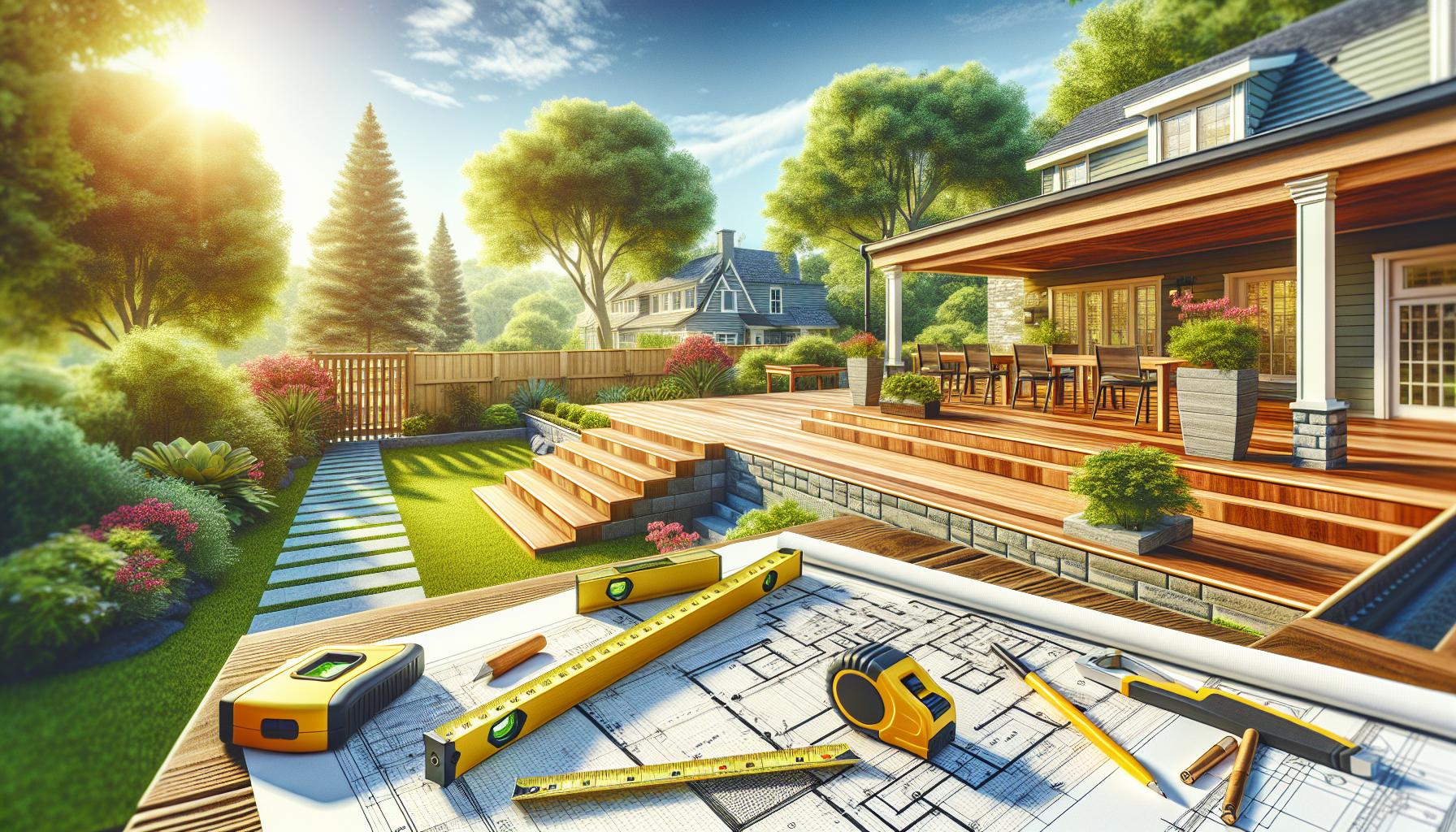Building a terrace can transform your outdoor space into a cozy retreat, but navigating building regulations can feel overwhelming. One of the most common questions I come across is how large a terrace can be without requiring a building permit. It’s a crucial detail that can save you time, money, and potential legal headaches.
The rules for terrace construction vary depending on local regulations, and understanding these guidelines is key to staying compliant. Whether you’re planning a small patio or a spacious deck, knowing the limits before you start can make all the difference. Let’s dive into what you need to consider to create your perfect terrace without unnecessary complications.
Understanding Terrace Construction Regulations
Terrace construction regulations vary by region but often depend on factors like size, height, and proximity to property boundaries. Local authorities set these rules to maintain safety and ensure community standards.
Several countries or local regions require a permit if a terrace exceeds specific dimensions. For instance, in Germany, many areas allow terraces up to 30 square meters without a permit, provided they don’t exceed 1 meter in height. If a terrace sits closer than the legally defined distance to a neighbor’s property, the likelihood of needing approval also increases.
Defining a terrace’s purpose and design impacts the permitting process. Structures with roofs, closed walls, or built-in utilities like water or electricity may require inspection, regardless of size. I recommend confirming whether unique elements, such as a pergola or attached lighting, fall under construction laws in your location.
What Does „Wie Groß Darf Eine Terrasse Sein Ohne Baugenehmigung“ Mean?

The phrase translates to „How large can a terrace be without requiring a building permit?“ It addresses the size limits for terrace construction that avoid legal or regulatory procedures.
Translating The Phrase
The question centers on terrace dimensions and when a building permit becomes necessary. It combines key aspects of size thresholds („wie groß“) and regulatory compliance („ohne Baugenehmigung“). The phrase indicates a focus on local building laws.
Context Of Terrace Size Restrictions
Terrace dimensions, including area and height, determine permit requirements. For instance, in some German regions, terraces below 30 square meters and under 1 meter in height often don’t need approval. Other factors like roof installation or proximity to neighboring properties may necessitate permits even if size rules are met. Each municipality sets specific standards to ensure safety and preserve neighborhood harmony.
Common Rules For Terrace Size Without A Permit

Understanding common regulations on terrace size helps avoid legal complications. Specific rules depend on location, features, and structural details.
Regional Variances In Regulations
Rules for terrace size vary by country and municipality. In Germany, terraces under 30 square meters and below 1 meter in height often don’t require permits. In contrast, stricter limits may apply in densely populated areas to prevent overdevelopment. Local authorities enforce these standards to ensure safety and aesthetic conformity within communities. I always recommend confirming with the local building office to account for zoning laws or neighborhood-specific provisions.
Factors Influencing Permit Requirements
Several elements determine if a terrace needs a permit. A terrace’s dimensions, such as height and total floor space, are typically the primary factors. For example, a terrace exceeding 1 meter in height frequently needs approval due to potential safety risks. Additional features like roofing, enclosed walls, or integrated utilities often classify the structure as more complex, increasing the likelihood of required permits. Proximity to property lines or shared boundaries also plays a role, as terraces built too close to neighboring properties may raise legal or zoning conflicts.
How To Ensure Compliance With Local Regulations

Understanding and following local building regulations helps avoid fines and disputes when constructing a terrace. Proper planning ensures your project aligns with legal requirements and prevents future issues.
Consulting Local Authorities
Contacting local authorities provides detailed information on terrace construction allowances. I recommend visiting the local building office or checking their official website for updated regulations. They can clarify zoning laws, size limitations, and permit exemptions specific to your location. For example, in some municipalities, terraces under 30 square meters and below 1 meter in height don’t require permits, but added features like roofs might change this status. Always confirm any neighborhood-specific policies, as homeowner associations often impose additional restrictions.
Practical Tips For Planning Your Terrace
Maintaining compliance while designing a terrace simplifies approval processes. I suggest starting with accurate measurements of your planned project, including area, height, and proximity to property lines. Avoid placing the terrace too close to boundaries to reduce neighbor disputes or zoning conflicts. Removing unnecessary additions, like permanent roofs or complex utilities, minimizes the chances of needing a permit. Keep documents, such as layout plans and material details, ready for authorities to review if required. This proactive approach ensures your terrace follows all legal and safety standards.
Consequences Of Ignoring Permit Requirements

Ignoring permit requirements for terrace construction often leads to legal, financial, and structural complications. Authorities may impose fines, demand alterations, or issue stop-work orders if specifications don’t meet local building codes. For unapproved structures, demolition could be mandated, resulting in wasted time and resources.
Selling a property with a non-compliant terrace becomes challenging. Potential buyers or inspectors may flag undocumented additions, delaying or voiding sales contracts. Insurance claims for damages related to unpermitted terraces may also be denied, leaving homeowners liable for repair costs.
Safety risks increase when terraces are built without adhering to regulations. Improper design or construction can compromise structural integrity, posing hazards to occupants. Compliance with permits ensures terraces maintain safety standards, protecting everyone involved.
Conclusion
Building a terrace without a permit requires careful attention to local regulations. Understanding the size, height, and design limits set by your municipality is essential to avoid legal or financial issues. Taking the time to research and consult with local authorities ensures your project complies with zoning laws and safety standards.
Proper planning not only protects you from potential penalties but also helps create a functional and enjoyable outdoor space. By staying informed and adhering to the rules, you can confidently move forward with your terrace construction while maintaining peace of mind.
Frequently Asked Questions
What factors influence whether a terrace needs a building permit?
The need for a building permit depends on the size, height, proximity to property boundaries, and additional features like roofing or walls. Local building regulations often set specific thresholds for these factors, so it’s essential to check with your local authorities.
How large can a terrace be without a building permit?
This varies by location. For example, in Germany, terraces up to 30 square meters and no taller than 1 meter may not need a permit. Always confirm local regulations as limits differ by municipality.
Why do terrace regulations vary between regions?
Terrace regulations are based on safety, community standards, and local zoning laws. Densely populated areas may have stricter rules to prevent overdevelopment and maintain harmony within neighborhoods.
What are the risks of building a terrace without a permit?
Ignoring permit requirements can lead to fines, stop-work orders, or demolition. It may also affect property sales and insurance claims. Non-compliant terraces can pose safety risks and structural hazards.
Do additional features on a terrace affect permit requirements?
Yes, features like roofs, enclosed walls, built-in utilities, or pergolas may require a permit regardless of the terrace’s size. These elements can change the classification of the structure, making compliance necessary.
How close can I build a terrace to property boundaries?
Proximity rules vary by region and are typically set to avoid disputes or privacy concerns. Check with local building codes to determine the minimum distance permitted.
What documents are needed when applying for a terrace permit?
Documents typically include design plans, property measurements, and location details. Additional paperwork may be required if the terrace includes special features like utility connections or roofing.
Can an unpermitted terrace be legalized later?
In some cases, unpermitted terraces can be approved retrospectively, but this process may involve inspections, modifications, or penalties. It’s easier and more cost-effective to obtain a permit beforehand.
How do I ensure my terrace complies with local laws?
Consult your local building office for specific guidelines, measure accurately, and avoid features that might require additional permits. Proper documentation and adhering to safety standards will help you stay compliant.
What are the consequences of selling a home with an unpermitted terrace?
Selling a home with an unpermitted terrace can delay transactions or void contracts, as inspectors or buyers may flag the illegal structure. This can reduce the property’s value or require costly corrections.

